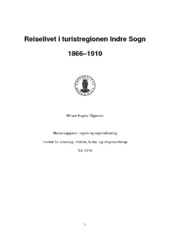| dc.contributor.author | Digernes, Miriam Kayser | |
| dc.date.accessioned | 2016-09-13T14:09:57Z | |
| dc.date.available | 2016-09-13T14:09:57Z | |
| dc.date.issued | 2016-05-18 | |
| dc.date.submitted | 2016-05-18 | eng |
| dc.identifier.uri | https://hdl.handle.net/1956/12791 | |
| dc.description.abstract | This thesis looks at how the tourism industry was established and how it affected the local societies in the region Indre Sogn in Norway from 1866 to 1910. This rural region first became popular among British fishing tourists early in the 19th century. The locals started building hotels to accommodate the tourists, and tourism was established as a means of income for the local inhabitants. The region's popularity accelerated in the 1880s when Germans became the new dominant group of visiting tourists. Before the First World War the tourism industry was blossoming in the small villages along the fjord. This paper looks at what type of work the tourism industry created, and how many people were involved in it in the period between 1866 and 1910. The tourist villages Balestrand and Flåm are the basis for this project, and they are used to create a picture of the development of tourism in the region as a whole. The main sources are the censuses from Statistisk sentralbyrå and local tax records for income and wealth. Both sources contain information about the types of jobs people in Balestrand and Flåm had. I also use historical books written about farms and ancestry in each of the villages to find records of work in the tourism industry. Last in the paper I examine how the tourism industry could have affected the population growth. The emigration rate was especially high in this part of Norway in the 19th century. This makes it is interesting to look at how tourism, as a new industry, could have made a difference for the population growth and emigration rate in the tourist villages. | en_US |
| dc.description.abstract | Oppgåva ser på korleis og i kva grad reiselivet påverka sysselsetjinga i regione Indre Sogn i perioden 1866-1910. Reiselivet vaks på denne tida fram som næring i regionen. Det sentrale i oppgåva er å finne kva arbeidsplassar som vart skapt av reiselivsnæringa, og konkret kor mange arbeidsplassar det var snakk om. Oppgåve tar for seg dei to turiststadane Balestrand og Flåm. Dei var sentrale i turisregionen Indre Sogn på denne tida. Til slutt i opgåva ser eg på forholdet mellom reiselivsnæringa og folketaltutviklinga på turiststadane. | en_US |
| dc.format.extent | 13006424 bytes | eng |
| dc.format.mimetype | application/pdf | eng |
| dc.language.iso | nno | eng |
| dc.publisher | The University of Bergen | eng |
| dc.subject | turistregion | eng |
| dc.subject | Indre Sogn | eng |
| dc.subject | Balestrand | eng |
| dc.subject | Flåm | eng |
| dc.subject | folketeljing | eng |
| dc.subject | likningsprotokoll | eng |
| dc.title | Reiselivet i turistregionen Indre Sogn 1866-1910 | eng |
| dc.type | Master thesis | |
| dc.rights.holder | Copyright the Author. All rights reserved | eng |
| dc.description.degree | Master i Region og regionalisering | |
| dc.description.localcode | MAHF-REG | |
| dc.description.localcode | REG350AHKR60 | |
| dc.subject.nus | 713999 | eng |
| fs.subjectcode | REG350AHKR60 | |
